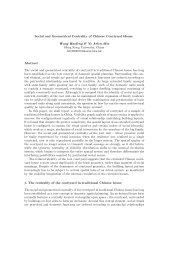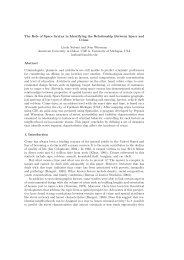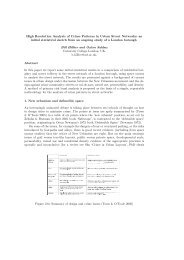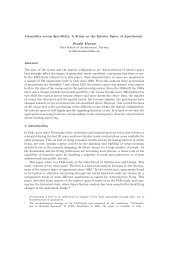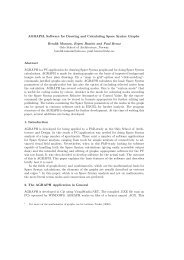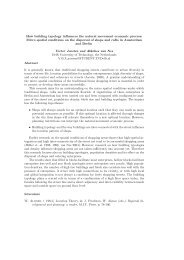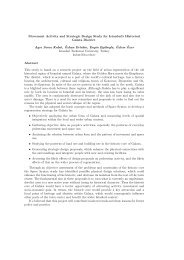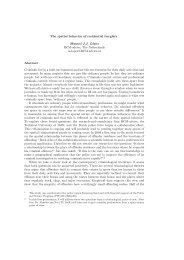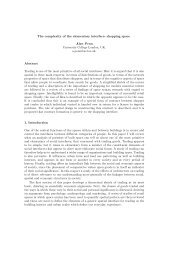Seen in a different light. Icons in Byzantine museums and churches ...
Seen in a different light. Icons in Byzantine museums and churches ...
Seen in a different light. Icons in Byzantine museums and churches ...
You also want an ePaper? Increase the reach of your titles
YUMPU automatically turns print PDFs into web optimized ePapers that Google loves.
254 G. Stavroulaki <strong>and</strong> J. Peponis<br />
def<strong>in</strong>ed with<strong>in</strong> the doma<strong>in</strong>. We will <strong>in</strong>troduce this proposition more fully by tak<strong>in</strong>g the<br />
Church of Capnikarea, built <strong>in</strong> the 11th century <strong>and</strong> located at the center of Athens, as<br />
an example.<br />
For economy of presentation, we will <strong>in</strong>troduce only the three layers of description that<br />
are fundamental to the subsequent argument. The church will be represented as: first, a<br />
field of <strong>in</strong>ter-visible positions us<strong>in</strong>g Alasdair Turner’s visibility graph analysis software,<br />
Depth Map; second, a field of illum<strong>in</strong>ation levels us<strong>in</strong>g Dr Andrew March’s (Square1<br />
research PTY LTD) <strong>light</strong><strong>in</strong>g analysis software, Ecotect; third, a field of <strong>in</strong>tersect<strong>in</strong>g gazes<br />
projected from the dom<strong>in</strong>ant persons shown <strong>in</strong> each wall pa<strong>in</strong>t<strong>in</strong>g or icon. This triad<br />
corresponds to a deliberate theoretical choice. We want to look at the church as a set<br />
of generic spatial relationships aris<strong>in</strong>g from its shape (visibility graph analysis), as a set<br />
of generic perceptual relationships aris<strong>in</strong>g from the manner <strong>in</strong> which the church admits<br />
day<strong>light</strong> (<strong>light</strong><strong>in</strong>g analysis), <strong>and</strong> a set of <strong>in</strong>tentional programmatic spatial relationships (the<br />
manner <strong>in</strong> which represented holy persons “look out” towards the space of congregation.)<br />
The decision to map gazes is not arbitrary. The “face to face” reciprocity between the<br />
gaze emanat<strong>in</strong>g from the pa<strong>in</strong>t<strong>in</strong>g <strong>and</strong> the gaze of the visitor is seen as fundamental<br />
to the religious bond by a number of authors (Eudokimof, 1972; Giannis E, 1996). The<br />
relationship between iconography <strong>and</strong> <strong>light</strong> is also a frequent theme <strong>in</strong> the literature with<br />
authors discuss<strong>in</strong>g both the symbolic association between god <strong>and</strong> <strong>light</strong> (Brotherhood of<br />
Monastery of Prodromos <strong>in</strong> Careas, 2000) <strong>and</strong> the manner <strong>in</strong> which Byzant<strong>in</strong>e pa<strong>in</strong>t<strong>in</strong>g<br />
styles emphasize <strong>light</strong> over shad<strong>in</strong>g (Skliris, 1991).<br />
2. Visual fields, <strong>light</strong><strong>in</strong>g fields, gazes<br />
When we look at the church as a spatial field def<strong>in</strong>ed by built shape <strong>and</strong> as a spatial field<br />
result<strong>in</strong>g from the distribution of <strong>light</strong> a significant polarity emerges. The best illum<strong>in</strong>ated<br />
areas (figure 105b) correspond to the outer-narthex, that is the transverse zone of space<br />
attached to the entrance; more limited areas of high illum<strong>in</strong>ation occur under the domes<br />
of the church <strong>and</strong> side chapel (the diagram is based on an analysis on a scale 0-300 lux,<br />
performed for <strong>light</strong><strong>in</strong>g conditions prevail<strong>in</strong>g on November 11, 11.30 am). The locations<br />
from which a greater part of the church would be directly visible had <strong>light</strong> been evenly<br />
distributed (greatest visibility polygon area) are mostly situated under the dome <strong>and</strong><br />
extend outwards to the edge along a longitud<strong>in</strong>al <strong>and</strong> a transverse axis (figure 105a) - the<br />
visually more <strong>in</strong>tegrated locations (figure 1c) follow the same pattern. Thus the core of<br />
best lit space <strong>and</strong> the core of potentially more panoramic views do not co<strong>in</strong>cide but reach<br />
towards each other from opposite poles. From the entrance, one senses the presence of<br />
greater space further <strong>in</strong>, but that space has to be discovered as it is veiled by darkness.<br />
Under the dome one is situated with<strong>in</strong> a smaller node of <strong>light</strong> <strong>and</strong> surrounded by darker<br />
space, with glimpses of the well lit outer narthex <strong>in</strong> the background.<br />
The gazes emanat<strong>in</strong>g from the wall pa<strong>in</strong>t<strong>in</strong>gs <strong>and</strong> the icons <strong>in</strong>tersect to create a network<br />
that covers the whole church. Whether we consider only the gazes that emanate from eye<br />
level or s<strong>light</strong>ly higher (fig 105d cont<strong>in</strong>uous l<strong>in</strong>es) or also <strong>in</strong>clude the gazes descend<strong>in</strong>g<br />
from the higher zone of the church (<strong>in</strong>clud<strong>in</strong>g the dome <strong>and</strong> the apses) (fig 105d dotted<br />
l<strong>in</strong>es), the denser web of <strong>in</strong>tersections occurs just off the <strong>in</strong>ner side of the narthex, as if to<br />
mediate between the zone of greater illum<strong>in</strong>ation <strong>and</strong> the zone of more panoramic views.<br />
We analyzed the network of <strong>in</strong>tersect<strong>in</strong>g gazes as if it was an axial map <strong>and</strong> observed<br />
an <strong>in</strong>terest<strong>in</strong>g difference accord<strong>in</strong>g to whether the gazes emanat<strong>in</strong>g from the higher zone


